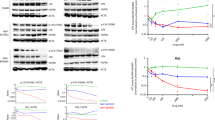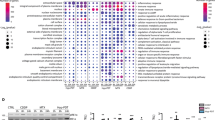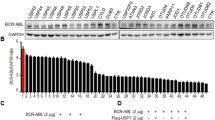Abstract
Chronic lymphocytic leukemia (CLL) is characterized by the accumulation of B cells in the hematopoietic system and lymphoid tissues. Although inhibitors targeting the B-cell receptor (BCR) pathway have been successful in the treatment of the disease, the underlying mechanisms leading to BCR over-activity in CLL are not fully understood. In this study, we found that HSP90, a highly conserved molecular chaperone, is overexpressed in CLL compared with resting B cells. HSP90 overexpression is accompanied by the overexpression of several BCR kinases including LYN, spleen tyrosine kinase, Bruton tyrosine kinase and AKT. Chemical and immune-precipitation demonstrated that these BCR constituents are present in a multi-client chaperone complex with HSP90. Inhibition of HSP90 with PU-H71 destabilized the BCR kinases and caused apoptosis of CLL cells through the mitochondrial apoptotic pathway. Further, PU-H71 induced apoptosis in the presence of stromal co-culture or cytoprotective survival signals. Finally, genetic knockdown of HSP90 and its client AKT, but not BTK, reduced CLL viability. Overall, our study suggests that the chaperone function of HSP90 contributes to the over-activity of the BCR signaling in CLL and inhibition of HSP90 has the potential to achieve a multi-targeting effect. Thus, HSP90 inhibition may be explored to prevent or overcome drug resistance to single targeting agents.
This is a preview of subscription content, access via your institution
Access options
Subscribe to this journal
Receive 50 print issues and online access
$259.00 per year
only $5.18 per issue
Buy this article
- Purchase on Springer Link
- Instant access to full article PDF
Prices may be subject to local taxes which are calculated during checkout








Similar content being viewed by others
References
Morton LM, Wang SS, Devesa SS, Hartge P, Weisenburger DD, Linet MS . Lymphoma incidence patterns by WHO subtype in the United States, 1992-2001. Blood 2006; 107: 265–276.
Chiorazzi N, Rai KR, Ferrarini M . Chronic lymphocytic leukemia. N Engl J Med 2005; 352: 804–815.
Rai KR, Jain P . Chronic lymphocytic leukemia (CLL)-then and now. Am J Hematol 2016; 91: 330–340.
Byrd JC, Furman RR, Coutre SE, Flinn IW, Burger JA, Blum KA et al. Targeting BTK with ibrutinib in relapsed chronic lymphocytic leukemia. N Engl J Med 2013; 369: 32–42.
Furman RR, Sharman JP, Coutre SE, Cheson BD, Pagel JM, Hillmen P et al. Idelalisib and rituximab in relapsed chronic lymphocytic leukemia. N Engl J Med 2014; 370: 997–1007.
Advani RH, Buggy JJ, Sharman JP, Smith SM, Boyd TE, Grant B et al. Bruton tyrosine kinase inhibitor ibrutinib (PCI-32765) has significant activity in patients with relapsed/refractory B-cell malignancies. J Clin Oncol 2013; 31: 88–94.
Sharman J, Hawkins M, Kolibaba K, Boxer M, Klein L, Wu M et al. An open-label phase 2 trial of entospletinib (GS-9973), a selective spleen tyrosine kinase inhibitor, in chronic lymphocytic leukemia. Blood 2015; 125: 2336–2343.
Landau DA, Carter SL, Stojanov P, McKenna A, Stevenson K, Lawrence MS et al. Evolution and impact of subclonal mutations in chronic lymphocytic leukemia. Cell 2013; 152: 714–726.
Landau DA, Tausch E, Taylor-Weiner AN, Stewart C, Reiter JG, Bahlo J et al. Mutations driving CLL and their evolution in progression and relapse. Nature 2015; 526: 525–530.
Puente XS, Bea S, Valdes-Mas R, Villamor N, Gutierrez-Abril J, Martin-Subero JI et al. Non-coding recurrent mutations in chronic lymphocytic leukaemia. Nature 2015; 526: 519–524.
Shrestha L, Patel HJ, Chiosis G . Chemical tools to investigate mechanisms associated with HSP90 and HSP70 in disease. Cell Chem Biol 2016; 23: 158–172.
Scaltriti M, Dawood S, Cortes J . Molecular pathways: targeting hsp90–who benefits and who does not. Clin Cancer Res 2012; 18: 4508–4513.
Trentin L, Frasson M, Donella-Deana A, Frezzato F, Pagano MA, Tibaldi E et al. Geldanamycin-induced Lyn dissociation from aberrant Hsp90-stabilized cytosolic complex is an early event in apoptotic mechanisms in B-chronic lymphocytic leukemia. Blood 2008; 112: 4665–4674.
Hertlein E, Wagner AJ, Jones J, Lin TS, Maddocks KJ, Towns WH 3rd et al. 17-DMAG targets the nuclear factor-kappaB family of proteins to induce apoptosis in chronic lymphocytic leukemia: clinical implications of HSP90 inhibition. Blood 2010; 116: 45–53.
Walsby E, Pearce L, Burnett AK, Fegan C, Pepper C . The Hsp90 inhibitor NVP-AUY922-AG inhibits NF-kappaB signaling, overcomes microenvironmental cytoprotection and is highly synergistic with fludarabine in primary CLL cells. Oncotarget 2012; 3: 525–534.
Gerecitano J, Modi S, Rampal R, Drilon AE, Fury MG, Gounder MM et al. Phase I trial of the HSP-90 inhibitor PU-H71. J Clin Oncol 2015; 33: abstr 2537.
Moulick K, Ahn JH, Zong H, Rodina A, Cerchietti L, Gomes DaGama EM et al. Affinity-based proteomics reveal cancer-specific networks coordinated by Hsp90. Nat Chem Biol 2011; 7: 818–826.
Zong H, Gozman A, Caldas-Lopes E, Taldone T, Sturgill E, Brennan S et al. A hyperactive signalosome in acute myeloid leukemia drives addiction to a tumor-specific Hsp90 species. Cell Rep 2015; 13: 2159–2173.
Taldone T, Ochiana SO, Patel PD, Chiosis G . Selective targeting of the stress chaperome as a therapeutic strategy. Trends Pharmacol Sci 2014; 35: 592–603.
Goldstein RL, Yang SN, Taldone T, Chang B, Gerecitano J, Elenitoba-Johnson K et al. Pharmacoproteomics identifies combinatorial therapy targets for diffuse large B cell lymphoma. J Clin Invest 2015; 125: 4559–4571.
Robertson LE, Plunkett W, McConnell K, Keating MJ, McDonnell TJ . Bcl-2 expression in chronic lymphocytic leukemia and its correlation with the induction of apoptosis and clinical outcome. Leukemia 1996; 10: 456–459.
Balakrishnan K, Burger JA, Wierda WG, Gandhi V . AT-101 induces apoptosis in CLL B cells and overcomes stromal cell-mediated Mcl-1 induction and drug resistance. Blood 2009; 113: 149–153.
Kitada S, Andersen J, Akar S, Zapata JM, Takayama S, Krajewski S et al. Expression of apoptosis-regulating proteins in chronic lymphocytic leukemia: correlations with in vitro and in vivo chemoresponses. Blood 1998; 91: 3379–3389.
Grzybowska-Izydorczyk O, Cebula B, Robak T, Smolewski P . Expression and prognostic significance of the inhibitor of apoptosis protein (IAP) family and its antagonists in chronic lymphocytic leukaemia. Eur J Cancer 2010; 46: 800–810.
Hayden RE, Pratt G, Roberts C, Drayson MT, Bunce CM . Treatment of chronic lymphocytic leukemia requires targeting of the protective lymph node environment with novel therapeutic approaches. Leuk Lymphoma 2012; 53: 537–549.
Burger JA . Nurture versus nature: the microenvironment in chronic lymphocytic leukemia. Hematol Am Soc Hematol Educ Program 2011; 2011: 96–103.
Andersen OS . Membrane proteins: through thick and thin. Nat Chem Biol 2013; 9: 667–668.
Cheng S, Guo A, Lu P, Ma J, Coleman M, Wang YL . Functional characterization of BTK mutation that confers ibrutinib resistance: exploration of alternative kinase inhibitors. Leukemia 2015; 29: 895–900.
Guo A, Lu P, Galanina N, Nabhan C, Smith SM, Coleman M et al. Heightened BTK-dependent cell proliferation in unmutated chronic lymphocytic leukemia confers increased sensitivity to ibrutinib. Oncotarget 2015; 7: 4598–4610.
Cheng S, Ma J, Guo A, Lu P, Leonard JP, Coleman M et al. BTK inhibition targets in vivo CLL proliferation through its effects on B-cell receptor signaling activity. Leukemia 2014; 28: 649–657.
Davis RE, Ngo VN, Lenz G, Tolar P, Young RM, Romesser PB et al. Chronic active B-cell-receptor signalling in diffuse large B-cell lymphoma. Nature 2010; 463: 88–92.
Duhren-von Minden M, Ubelhart R, Schneider D, Wossning T, Bach MP, Buchner M et al. Chronic lymphocytic leukaemia is driven by antigen-independent cell-autonomous signalling. Nature 2012; 489: 309–312.
Furman RR, Cheng S, Lu P, Setty M, Perez AR, Guo A et al. Ibrutinib resistance in chronic lymphocytic leukemia. N Engl J Med 2014; 370: 2352–2354.
Woyach JA, Furman RR, Liu TM, Ozer HG, Zapatka M, Ruppert AS et al. Resistance mechanisms for the Bruton's tyrosine kinase inhibitor ibrutinib. N Engl J Med 2014; 370: 2286–2294.
Liu TM, Woyach JA, Zhong Y, Lozanski A, Lozanski G, Dong S et al. Hypermorphic mutation of phospholipase C, gamma2 acquired in ibrutinib-resistant CLL confers BTK independency upon B-cell receptor activation. Blood 2015; 126: 61–68.
Song Z, Lu P, Furman RR, Leonard JP, Martin P, Tyrell L et al. Activities of SYK and PLCgamma2 predict apoptotic response of CLL cells to SRC tyrosine kinase inhibitor dasatinib. Clin Cancer Res 2010; 16: 587–599.
Haerzschel A, Catusse J, Hutterer E, Paunovic M, Zirlik K, Eibel H et al. BCR and chemokine responses upon anti-IgM and anti-IgD stimulation in chronic lymphocytic leukaemia. Ann Hematol. 2016; 95: 1979–1988.
Yang C, Lu P, Lee FY, Chadburn A, Barrientos JC, Leonard JP et al. Tyrosine kinase inhibition in diffuse large B-cell lymphoma: molecular basis for antitumor activity and drug resistance of dasatinib. Leukemia 2008; 22: 1755–1766.
Lu P, Yang C, Guasparri I, Harrington W, Wang YL, Cesarman E . Early events of B-cell receptor signaling are not essential for the proliferation and viability of AIDS-related lymphoma. Leukemia 2009; 23: 807–810.
Ma J, Xing W, Coffey G, Dresser K, Lu K, Guo A et al. Cerdulatinib, a novel dual SYK/JAK kinase inhibitor, has broad anti-tumor activity in both ABC and GCB types of diffuse large B cell lymphoma. Oncotarget 2015; 6: 43881–43896.
Cheng S, Coffey G, Zhang XH, Shaknovich R, Song Z, Lu P et al. SYK inhibition and response prediction in diffuse large B-cell lymphoma. Blood 2011; 118: 6342–6352.
Author information
Authors and Affiliations
Corresponding author
Ethics declarations
Competing interests
Memorial Sloan-Kettering Cancer Center holds the intellectual rights to PU-H71 (GC). Samus Therapeutics, of which GC has partial ownership, has licensed PU-H71. The remaining authors declare no conflict of interest.
Additional information
Supplementary Information accompanies this paper on the Oncogene website
Rights and permissions
About this article
Cite this article
Guo, A., Lu, P., Lee, J. et al. HSP90 stabilizes B-cell receptor kinases in a multi-client interactome: PU-H71 induces CLL apoptosis in a cytoprotective microenvironment. Oncogene 36, 3441–3449 (2017). https://doi.org/10.1038/onc.2016.494
Received:
Revised:
Accepted:
Published:
Issue Date:
DOI: https://doi.org/10.1038/onc.2016.494
This article is cited by
-
Heat shock protein 90 is a new potential target of anti-rejection therapy in allotransplantation
Cell Stress and Chaperones (2022)
-
Ibrutinib and venetoclax target distinct subpopulations of CLL cells: implication for residual disease eradication
Blood Cancer Journal (2021)
-
HSP90 inhibitor PU-H71 increases radiosensitivity of breast cancer cells metastasized to visceral organs and alters the levels of inflammatory mediators
Naunyn-Schmiedeberg's Archives of Pharmacology (2020)
-
Adapting to stress — chaperome networks in cancer
Nature Reviews Cancer (2018)



